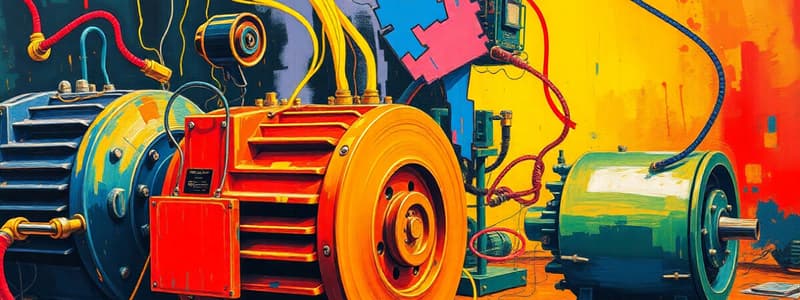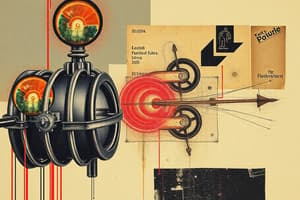Podcast
Questions and Answers
What is the primary function of motors in electrical systems?
What is the primary function of motors in electrical systems?
- Convert mechanical energy into electrical energy
- Increase voltage levels for transmission
- Transform electrical energy into mechanical energy (correct)
- Change the direction of current flow
Which of the following losses in transformers is associated with circulating currents in the core?
Which of the following losses in transformers is associated with circulating currents in the core?
- Copper losses
- Hysteresis losses
- Resistance losses
- Eddy currents (correct)
What characteristic differentiates alternating current (AC) from direct current (DC)?
What characteristic differentiates alternating current (AC) from direct current (DC)?
- AC flows in one direction, while DC periodically reverses
- AC has a constant voltage level, whereas DC varies
- AC is primarily used in batteries, while DC is used for power transmission
- AC changes direction periodically, while DC flows in one direction (correct)
How can copper losses in transformers be minimized?
How can copper losses in transformers be minimized?
What is the purpose of stepping up voltage levels in transformers during power transmission?
What is the purpose of stepping up voltage levels in transformers during power transmission?
What is the primary function of a DC motor?
What is the primary function of a DC motor?
Which component ensures continuous rotation in a DC motor?
Which component ensures continuous rotation in a DC motor?
What causes the rotation of the armature in a DC motor?
What causes the rotation of the armature in a DC motor?
In the context of the motor effect, what is the relationship between the direction of the force, the current, and the magnetic field?
In the context of the motor effect, what is the relationship between the direction of the force, the current, and the magnetic field?
Which of the following accurately describes the split-ring commutator in a DC motor?
Which of the following accurately describes the split-ring commutator in a DC motor?
How does the current in the armature affect the magnetic field in a DC motor?
How does the current in the armature affect the magnetic field in a DC motor?
What is the principle behind the motor effect in a current-carrying conductor?
What is the principle behind the motor effect in a current-carrying conductor?
What role does the arrangement of coils play in the effectiveness of a DC motor?
What role does the arrangement of coils play in the effectiveness of a DC motor?
Flashcards
Transformer Power Equation
Transformer Power Equation
The power input to a transformer is equal to the power output, neglecting losses.
Eddy Currents
Eddy Currents
Circulating currents in the transformer core caused by changing magnetic fields.
Hysteresis Losses
Hysteresis Losses
Energy lost due to the core's magnetization and demagnetization cycles.
Copper Losses
Copper Losses
Signup and view all the flashcards
Alternating Current (AC)
Alternating Current (AC)
Signup and view all the flashcards
Electromagnetism
Electromagnetism
Signup and view all the flashcards
Electromagnet
Electromagnet
Signup and view all the flashcards
Motor Effect
Motor Effect
Signup and view all the flashcards
DC Motor
DC Motor
Signup and view all the flashcards
Split-ring commutator
Split-ring commutator
Signup and view all the flashcards
Transformer
Transformer
Signup and view all the flashcards
Step-up transformer
Step-up transformer
Signup and view all the flashcards
Step-down transformer
Step-down transformer
Signup and view all the flashcards
Study Notes
Electromagnetism
- Electromagnetism describes the interaction between electricity and magnetism.
- A current-carrying wire generates a magnetic field around it.
- The magnetic field's direction is determined by the current's direction (right-hand rule).
Electromagnets
- An electromagnet consists of a wire coil wrapped around a core (often iron).
- A current flowing through the coil creates a strong magnetic field in the core.
- The magnetic field's strength is proportional to the current and the number of turns in the coil.
- Electromagnets are used in various devices, including motors and relays.
The Motor Effect
- A current-carrying conductor in a magnetic field experiences a force.
- The force's direction is perpendicular to both the current and the magnetic field.
- This force drives the operation of electric motors.
Simple DC Motor
- A DC motor transforms electrical energy into mechanical energy using the motor effect.
- Key components include a wire coil (armature), a magnetic field (permanent magnets or electromagnets), and a split-ring commutator.
- The commutator reverses the current flow in the armature, ensuring continuous rotation.
- The armature's rotation is caused by the force on the current-carrying coils within the magnetic field.
Transformers
- Transformers alter the voltage of an alternating current (AC) supply.
- They comprise two coils (primary and secondary) wound around a soft-iron core.
- Step-up transformers increase voltage (more secondary turns than primary).
- Step-down transformers decrease voltage (fewer secondary turns).
- The transformer's operation relies on a changing magnetic field in the core generated by AC in the primary coil.
- This changing field induces a voltage in the secondary coil.
- The secondary voltage is proportional to the turns ratio (secondary turns / primary turns).
Ideal Transformer
- An ideal transformer has no energy losses.
- Input power equals output power (Pin = Pout).
- Voltage ratio equals turns ratio (Vp / Vs = Np / Ns).
Real Transformers
- Real transformers have unavoidable energy losses.
- Output voltage might differ from the expected value.
Energy Losses in Transformers
- Eddy currents: Circular currents in the core from changing magnetic fields. Minimized via laminated cores.
- Hysteresis losses: Energy lost due to core's magnetization/demagnetization cycles. Minimized using low hysteresis soft iron.
- Copper losses: Heating in the wires from current flow. Minimized by using thicker wires for high currents.
Uses of Transformers
- Power transmission: Increases voltage for efficient long-distance transmission.
- Domestic appliances: Decreases voltage to safe levels for household use.
- Matching voltage levels to suit specific components and circuits.
AC and DC
- Alternating current (AC): Current periodically reverses direction.
- Direct current (DC): Current flows in one direction only.
- Motors convert electrical energy (AC or DC) into mechanical energy.
- Generators convert mechanical energy into electrical energy.
Studying That Suits You
Use AI to generate personalized quizzes and flashcards to suit your learning preferences.




